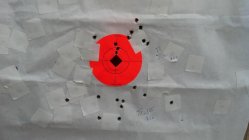skiutah02
Silver $$ Contributor
Just sharing some information recently obtained at the range, but have not seen reported here or elsewhere. I developed a good load for my 20" 1/8 Windham AR using Hornady's 75 gr HPBT that I used in 600 yd FTR last summer. I acquired some 77SMKs this winter and was personally wondering which might be better. I needed to redo the load since I got a new barrel and new lot of powder, so I worked up a <MOA load for each. Ended up that the "best" accuracy node for each was the same charge with the same powder, so here is the experiment.
Using fully prepped, 6x fired LC brass that was weight sorted and H2O-capacity sorted, I prepared 17 rounds of 77SMK and 16 rounds of 75 HPBT using same powder and randomly selected cases. Nearly everything was identical except the primer was a BR4 for the 75 and a F205M for the 77SMK. After some fouling rounds on a clean barrel, I shot 10 of each, one-by-one round robin style at a target 300 yds out aiming at the same point. Did not correct for wind or adjust scope. Used a Magnetospeed chronograph to get velocities. The higher MV and higher published BC of the Hornadys showed that the calculated drop would be less for the 75s than the SMK. That did not prove to be true (see picture). The ave MV, ES and SD was with all rounds but the target was inspected and photographed after 10 of each. It is a 3" sticker for reference.
Final analysis: The 75s had more drop at 300 than the 77SMKs, even though calculations gave the opposite. Anybody else observe this?
Drew
Some detail:
300 yd
34oC
5:30-6:30 tailwind switching badly, but 5-6 mph
75 HPBT MV 2752, ES 53, SD 14
77 SMK MV 2724, ES 42, SD 13
Using fully prepped, 6x fired LC brass that was weight sorted and H2O-capacity sorted, I prepared 17 rounds of 77SMK and 16 rounds of 75 HPBT using same powder and randomly selected cases. Nearly everything was identical except the primer was a BR4 for the 75 and a F205M for the 77SMK. After some fouling rounds on a clean barrel, I shot 10 of each, one-by-one round robin style at a target 300 yds out aiming at the same point. Did not correct for wind or adjust scope. Used a Magnetospeed chronograph to get velocities. The higher MV and higher published BC of the Hornadys showed that the calculated drop would be less for the 75s than the SMK. That did not prove to be true (see picture). The ave MV, ES and SD was with all rounds but the target was inspected and photographed after 10 of each. It is a 3" sticker for reference.
Final analysis: The 75s had more drop at 300 than the 77SMKs, even though calculations gave the opposite. Anybody else observe this?
Drew
Some detail:
300 yd
34oC
5:30-6:30 tailwind switching badly, but 5-6 mph
75 HPBT MV 2752, ES 53, SD 14
77 SMK MV 2724, ES 42, SD 13













